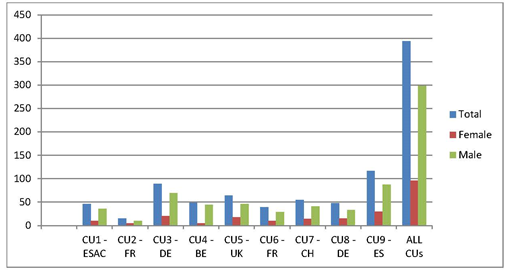Gender on Gaia DPAC (6 April, 2017)
Gender on Gaia DPAC
Thursday, 6 April, 2017
Link to the web: http://gaiaverse.eu/fre_news/gender-on-gaia-dpac/
The number of women entering the sciences and earning degrees is increasing in all fields but one: computer science. Despite progress, the under representation of women continues to be a problem in all narrow fields of science and engineering, except life science. The average of the International Astronomical Union statistics for 2015 is a 16% of female permanent positions in astronomy. Women remain severely underrepresented within the sub-field of computing. Recent figures from “She Figures 2015” indicate that the proportion of female PhD (ISCED6) graduates in computer science is still only 21% at EU-28. Thus, it is mandatory to stimulate young woman researchers’ careers in computer science.
The number of women scientist and engineers in the total labour force is, at the level of the EU-28, also showing a gender gap. Men continue to make up a greater proportion of scientist and engineers (4.1 vs a 2.8) in the total labour force, exceeding the proportion of women by 1.3 percentage points. In 20 of those 28 countries this gap falls below the EU-28 average, and in Finland, Luxembourg and Switzerland, the proportion of men scientist and engineers exceeds the proportion of women by over 3.5 percentage points. In the 8 countries taking part in GENIUS (Spain, France, United Kingdom, the Netherlands, Italy, Switzerland, Belgium and Portugal), the average is a difference of 1.5 percentage points, with Portugal having almost gender balance (0.1 percentage points), and Spain (0.3), in contrast with the worst cases, the Netherlands (2.1) and Switzerland, with 3.6 percentage points in favour to men.
The proportion of women researcher is growing in the EU-28 in the period 2005 – 2011 (covered by the “She Figures 2015”) at a rate of 4.8% in contrast to a 3.3% for men. With the exception of Iceland, Macedonia, Romania and Sweden, there has been a general increase in the number of both women and men researchers. In the majority of countries, the number of women researchers has been growing at a faster rate than that of men.
Nevertheless, when dealing with the figures in She Figures 2015 and this study, it is important to keep in mind that all the data presented throughout are measured in headcounts and thus fail to take into account that much of the women employment is part-time in the research population.
Gender on Gaia DPAC
Of the 431 full members of the Data Processing and Analysis Consortium (DPAC), 329 are men and 102 are women, representing the 24% of the total.
This DPAC is structured in 9 sub-units (known as Coordination Units), formed by 394 members, of which 96 are women (24%).
See below the percentage of women in all CUs in comparison to the total number, from the lowest CU4 (Object Processing) having only a 10%, to the highest, CU2 (Data Simulations), with a 33%.
Women in CUS
The data from the Data Processing Centres is more linked to pure computing engineering and less to scientific profiles, so it is expected to have a lower number of women representation. Moreover, it is also more linked to specific countries, being the lowest percentage of women participation from Switzerland and the highest to France, also as expected.
Representation in the DPAC governing bodies (DPACE, PO, GST) shows as well an average 28 percentage of women participation. The highest correspond to the GST, the more scientific one, the lowest to the Project Office where there are only 2 women out of 9 members.
Representation of women in Meetings
Meetings encompassing the whole of DPAC and medium-sized meetings have 24% of women, which increases up to two points (26%) in medium-sized meetings.
Women in meetings
Representation of women in User Requirements and Beta Testing Group
One of the actions foreseen in the project to ensure as much as possible the gender balance, was dedicated to the set of users defining the requirements for the DPAC systems and tools, as well as in the set of testing users validating them. The aim was not only contribute to the gender balance in the DPAC community, but also to help avoiding gender-bias in its design. It is formed by 23 men and 13 women (36%).
The Archive Beta Testing Group consists of 18 men and 10 women. That is another 36%.
Gaiaverse: public outreach
The Gaiaverse Twitter profile has 434 followers, of which 26% are women.
Indeed, the profile of our followers can also be studied in comparison to our “Organic audiences”, that is all those that interact with our Tweets, whatever they are followers or not.
With this comparison we can see that the percentage of women that follow directly our contents about Gaia through Gaiaverse profile is a 26%. This is a 5% higher than the percentage of women that could be potential followers (21%). This means that Gaiaverse has managed to attract 5% more women than our organic audience, those that you reach because they are interested in the subject.
Conclusions
Gaia DPAC results for a 25% of women participation in more scientific groups (CUs) and a 19% in more computational ones (DPCs).
With a total of 24%, these are significant numbers considering the known percentages in related fields. However, gender bias is still a major problem in computational and space science and it is clear that time will not redress the under-representation of women in an adequate fashion and that specific measures are needed.







